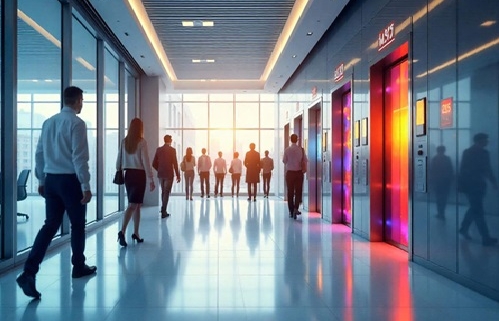Elevator Destination Control System: A Modern Solution to Reduce False Traffic, Enable Online Monitoring, and Enhance Security with Access Control
Reducing Elevator Traffic
The Importance of the Issue:
Elevator destination control systems significantly reduce false traffic by eliminating unnecessary stops and optimizing travel routes. This technology not only improves system efficiency but also enhances security in office buildings, hospitals, hotels, shopping centers, and residential complexes by enabling real-time elevator monitoring and smart access control.
Definition of the Destination Control System
The destination control system is an advanced technology used for managing elevator service in high-rise and high-traffic buildings. In this system, passengers select their destination at the origin point, and the system assigns them the most suitable elevator. This groups passengers by destination, eliminating redundant stops and improving service speed.
Unlike conventional systems, where passengers can press buttons inside the cabin, destination control only allows destination selection at the lobby. This prevents unnecessary stops and reduces instances of passengers boarding in the wrong direction. Additionally, the system overcomes limitations in buildings with unique architectural designs—such as elevators with uneven stops, varying floor alignments, or separate lobbies—by intelligently assigning elevators based on passenger destinations.
False Traffic in Group Elevators
During peak hours, passengers often press both up and down call buttons due to crowded elevators, causing two elevators to stop at the same floor unnecessarily. Since the passenger only boards one elevator, the other makes a wasted stop. Moreover, passengers sometimes board elevators going in the opposite direction, leading to inefficiencies where elevators continue moving without discharging passengers.
This results in unnecessary passenger movement, delays, reduced service speed, increased wear and tear, and lower elevator efficiency. With destination control, passengers must select their destination in advance, eliminating the incentive to press multiple buttons and reducing false stops.
Online Access to Elevators
A key feature of destination control systems is the ability to define different service scenarios for various floors at different times. For example:
-
In office buildings, priority service can be assigned to specific floors during defined hours.
-
In hospitals, access to intensive care units or restricted wards can be controlled outside visiting hours.
-
In hotels, guest access to the restaurant floor can be limited to operational hours.
The system also supports dynamic scheduling based on time and date, allowing administrators to adjust elevator behavior for different conditions. For instance:
-
During morning rush hours, elevators prioritize upward movement and position themselves at building entrances.
-
On holidays, access to office floors can be automatically restricted.
-
In emergencies (e.g., fires), the system can execute an intelligent evacuation protocol.
-
During low-traffic periods, the number of active elevators can be reduced.
A comprehensive online management panel provides real-time monitoring, analytical reports, and instant adjustments. Implementing this system transforms large and complex building management into a fully intelligent and flexible process—a necessity for high-rise buildings in urban areas.
Enhancing Security with Access Control Integration
Destination control systems integrated with access control technology revolutionize security in modern buildings. These systems enable precise and flexible restrictions, ensuring users only access authorized floors.
Key features include:
-
Smart card-based access levels: In hotels, guests can only access their assigned floor and common areas using their room key.
-
VIP elevator service: Senior executives and special guests can summon dedicated elevators with priority service, bypassing other passengers.
-
Emergency override: During crises like fires, access restrictions are automatically lifted to facilitate evacuation.
This integration provides a new level of security and smart management for offices, hospitals, hotels, and luxury residences, meeting both safety and convenience needs.
Conclusion
Elevator destination control systems represent an intelligent and transformative solution for vertical traffic management in high-rise, high-traffic buildings. By optimizing elevator movement—eliminating unnecessary stops, grouping passengers by destination, and preventing false traffic—these systems dramatically improve efficiency while saving time and energy.
Standout features like smart access control, dynamic scenario planning via web applications, VIP elevator assignment, and automated emergency responses elevate this system from a basic solution to a comprehensive vertical traffic management platform.





Leave a Reply
Want to join the discussion?Feel free to contribute!